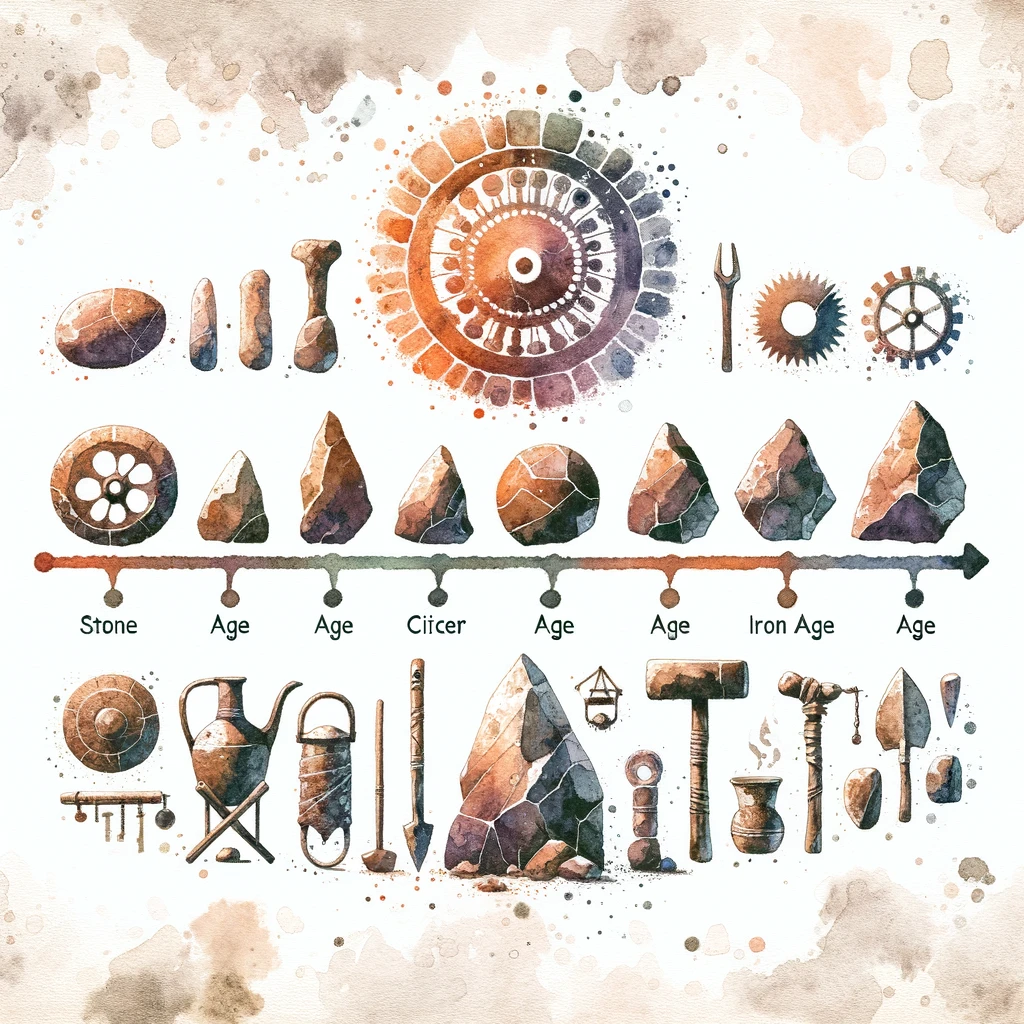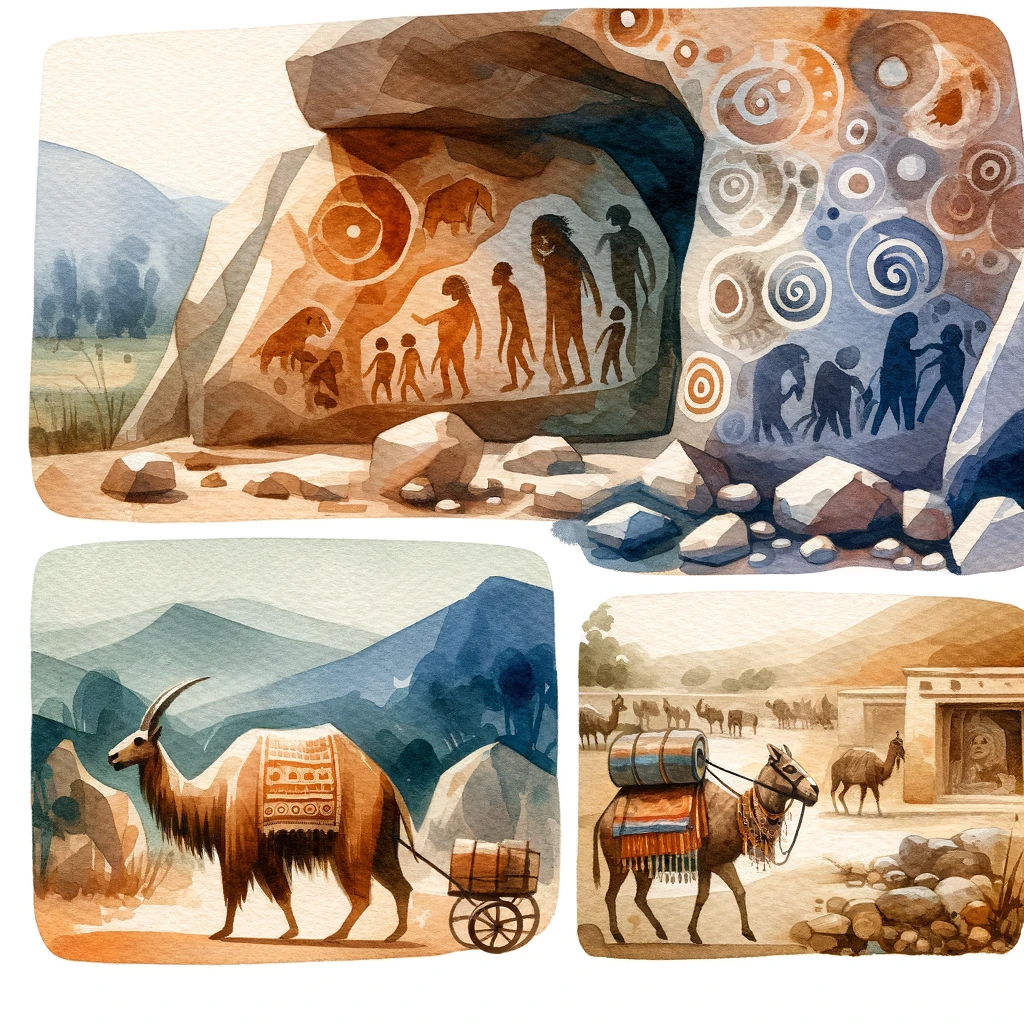Indian prehistory is a fascinating journey through time, marked by significant technological and cultural advancements. The periodization of Indian prehistory is broadly divided into distinct ages based on the predominant materials used for tools and artifacts. The Stone Age (including the Palaeolithic, Mesolithic, and Neolithic periods), the Chalcolithic Age, and the Iron Age. Each of these periods showcases unique developments in human life, society, and technology.

Stone Age
The Stone Age in India is characterized by the use of stone tools and is divided into three phases: the Palaeolithic, Mesolithic, and Neolithic periods.
Palaeolithic Period (Old Stone Age)
The Palaeolithic period is the earliest phase of the Stone Age, dating from approximately 2 million BCE to 10,000 BCE. It is further divided into the Lower, Middle, and Upper Palaeolithic. These are based on the sophistication of tools and artifacts.
Lower Palaeolithic:
- Early human ancestors used crude stone tools like hand axes and choppers.
- Sites: Important sites include the Soan Valley (now in Pakistan), Bhimbetka (Madhya Pradesh), and Attirampakkam (Tamil Nadu).
- Lifestyle: People were primarily hunter-gatherers, relying on wild animals and plants for sustenance.
Middle Palaeolithic:
- Tools became more refined, with the use of flake tools and scrapers.
- Sites: Notable sites include Nevasa (Maharashtra) and Patne (Maharashtra).
- Lifestyle: The social organization likely became more complex, with improved hunting strategies.
Upper Palaeolithic:
- This period saw the emergence of blade tools and burins.
- Sites: Bhimbetka and Belan Valley (Uttar Pradesh) are significant Upper Palaeolithic sites.
- Lifestyle: Art and symbolic behavior, such as cave paintings in Bhimbetka, indicate cognitive and cultural advancements.
Mesolithic Period (Middle Stone Age)
The Mesolithic period, dating from approximately 10,000 BCE to 8,000 BCE, marks a transitional phase between the Palaeolithic and Neolithic periods.
Tools:
- Characterized by microliths—small, finely crafted stone tools often set in wooden or bone handles.
- Hunting, fishing, and crafting were done using these tools.
Sites:
Significant sites include Bagor (Rajasthan), Langhnaj (Gujarat), and Adamgarh (Madhya Pradesh).
Lifestyle:
- People continued to live as hunter-gatherers but began to develop semi-permanent settlements.
- The period saw the domestication of animals and early attempts at agriculture.
Neolithic Period (New Stone Age)
The Neolithic period, dating from approximately 8,000 BCE to 4,000 BCE, marked the advent of agriculture and settled life.
Tools:
- Polished stone tools, such as sickles and grinding stones, became common.
- The use of pottery also emerged, indicating advancements in storage and cooking methods.
Sites:
Key sites include Mehrgarh (now in Pakistan), Chirand (Bihar), and Burzahom (Jammu and Kashmir).
Lifestyle:
- The Neolithic Revolution brought about the domestication of plants and animals, leading to settled agricultural communities.
- Permanent houses were built and villages developed, signifying a shift from nomadic to sedentary life.
Chalcolithic Age (Copper-Stone Age)
The Chalcolithic Age, dating from approximately 4,000 BCE to 1,500 BCE, is marked by the use of copper alongside stone tools. This period saw the first use of metal tools in India.
Tools and Artifacts:
- The use of copper tools and weapons alongside stone tools.
- Pottery became more sophisticated, with intricate designs and decorations.
Sites:
Important sites include Ahar (Rajasthan), Jorwe (Maharashtra), and Gilund (Rajasthan).
Lifestyle:
- Agriculture and animal husbandry continued to be the mainstay of the economy.
- There was a significant increase in trade and interaction among different communities, leading to cultural exchanges and technological innovations.
Iron Age
The Iron Age in India started from approximately 1,500 BCE to 200 BCE. It is characterized by the widespread use of iron tools and weapons. This period witnessed major societal and cultural transformations.
Tools and Artifacts:
- Iron tools, such as plows, sickles, and weapons, became prevalent.
- The use of iron significantly improved agricultural productivity and warfare capabilities.
Sites:
Key sites include Hallur (Karnataka), Atranjikhera (Uttar Pradesh), and Adichanallur (Tamil Nadu).
Lifestyle:
- The Iron Age saw the rise of complex societies and the formation of early states and kingdoms.
- Significant advancements in agriculture, trade, and urbanization occurred.
- The Vedic texts, composed during this period, provide valuable insights into the social, religious, and political life of the time.
Learn more about Major Prehistoric Sites in India.
Conclusion
The periodization of Indian prehistory into the Stone Age, Chalcolithic Age, and Iron Age provides a structured framework to understand the evolution of human societies in the Indian subcontinent. Each period marked significant technological and cultural advancements that laid the foundation for the complex civilizations that followed. For UPSC aspirants, understanding these periods is crucial for appreciating the depth and richness of India’s ancient heritage.


